By Jeffrey A. Rendall, Photos By Jeff Janas
|
|
POTOMAC FALLS, VA -- Hills on the Potomac River. For those familiar with the mighty Potomac, the thought of hills or cliffs along the banks would come as no surprise -- for much of its length above Washington DC, there's nary a flat spot to be found.
But in this sense, we're talking about a different kind of Hills -- that being Arthur Hills, the respected golf architect and creative mind behind Lowes Island Club's River Course in Potomac Falls, Virginia (mailing address is in Sterling). As the name suggests, the River Course rests alongside the Potomac, though the river itself won't come into play unless you hook one horrendously from the tee of the par three seventh hole.
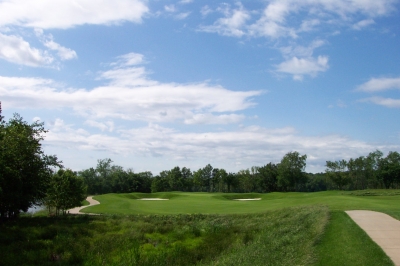 |
| The River Course's par five 6th hole features challenge on all three shots. |
Nevertheless, a trip around the River Course is a majestic journey through a private, serene and natural patch of Northern Virginia, and it certainly doesn't hurt to have the flowing waters of the great river right next door for aesthetic value.
According to Lowes Island Club's Director of Golf, Bob Fikac, the River Course was always in the plans, though it opened six years after the club's Tom Fazio designed Island Course: "Our club's original concept included two courses, the first obviously being the Island Course. Since Fazio designed the first one, we wanted a different flavor for the second layout. We looked up and down the east coast, playing and seeing some of the different architects' courses, and we really liked what we saw with Arthur Hills."
Perhaps Hills and the Potomac just seemed to go together, but in any case, the match-up turned out to be a good one. Hills took a basically flat and featureless patch of ground adjacent to the river and created a low-lying, links-style course -- certainly one of the finer private layouts in the Washington DC metro area.
Hills should know, since he's had a hand in renovating a good share of the area's prestigious private courses. But for Lowes Island, it was all done from scratch: "There really wasn't anything distinguishable about the ground when we first saw it, but of course it was right alongside the Potomac River and was very scenic. It was just a dead flat piece of land with no trees on that part of the site. Our goal was to build the course -- but also to prevent the land from being flooded by the river. So, we basically built a dike around the entire site, then placed the golf course in a fairly limited amount of acreage."
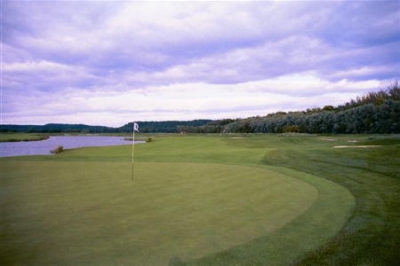 |
| Looking back from the 15th green. Risk-reward of several varieties, with water, bunkers and deep rough to contend with. |
With its proximity to the water, along with a prevalent wind blowing at nearly all times, it made sense to work in some links-style elements, namely strategic bunkering and many risk-reward type situations. Hills elaborates: "We designed the River Course to require players to think their way around the layout, with a lot of strategic qualities. The course has many dramatic situations, where you'll have risks and rewards, but also a bailout option. I also think the course has a lot of interesting shaping to it."
To shape flat, unremarkable ground, you need dirt. That's a bit of a story in itself, and Hills was kind enough to share it with us: "We were hard pressed to get enough fill to build the River Course, so we just kept excavating more and more lakes until we got enough dirt -- although eventually we were able to get some dirt from a piece of property contiguous to the golf course, just upstream there."
One only wonders what the course would be like if they hadn't found additional soil resources from that second piece of property, because as Hills hints at above, there's already quite a lot of water on the River Course (sounds natural, doesn't it?). Fikac said the course contains the largest lake that Hills ever created, and there's plenty of wet stuff on the layout to keep you entertained.
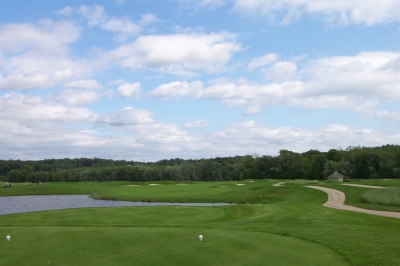 |
| The par four 9th hole is one of several excellent short-to-medium length two-shotters on the River Course. |
But the soil was also put to good use. "We tried not to create just round mounds, but kind of lineal landforms," said Hills. "I worked close with the shaper on that project, and I'd have to say it's some of the finest shaping work we've ever done."
No arguments here. Glance over the landscape and the forms seem to flow as effortlessly as the waves on the Potomac. You'll hardly believe that you're just outside the DC beltway, but the 'escape' is what membership in a club is for in the first place. Lowes Island rates high in this category.
Fikac says the links-style and natural beauty sets the River Course apart from the competition: "Most new golf courses these days are built in residential communities, and the River Course's location, right on the Potomac River, really distinguishes it. There are no homes on the layout, in its entirety (there will be a few seen from the 18th hole in the future, but that's it)."
"It's a links-style golf course in Washington DC. Usually you'd see that type of course on the eastern seaboard or down south, but you don't see it much in this area. We've got some of the links 'look' out there, with the fescue grasses growing in the non-playing areas, and even some play areas, actually. The wind also plays a big factor, and the course changes each and every day because of it. It's nice to have during the summertime, when we get a breeze off the river," Fikac said.
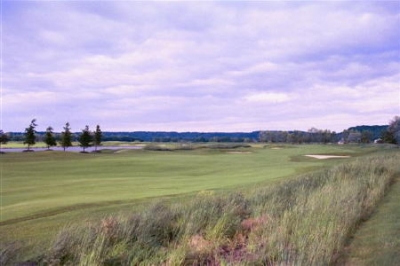 |
| It seems you're never far away from some tall fescue grasses. The River Course has definite links-style accents. |
And, as you'd expect, humans aren't the only inhabitants of the land. "We also see quite a lot of wildlife down there. You've got geese and fox and deer -- and seeing them, you just don't get that feeling in a metropolitan area," Fikac added.
With water coming into play on ten out of the eighteen holes, the course can play pretty difficult. The back tees stretch to a little over 7000 yards, and the slope is a toothy 144. In addition to the plentiful water hazards, hitting it in the well maintained rough can also be a penalty -- the day we played, it was difficult to advance very far when we found the primary cut.
Most of the greens provide a run-up option (another links quality), yet the putting surfaces are small targets and protected by ample bunkering. Fikac describes the challenge: "The greens are relatively small for a course of this type, and they're undulating and firm."
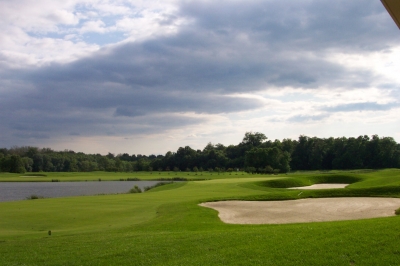 |
| Some late afternoon cloud cover helps highlight the tremendous shaping of the River Course. Here, the par five 11th hole. |
As Arthur Hills alluded to above, Fikac is also quick to point out the River Course's strategic qualities: "It's a shot-makers course. There're many times when Hills makes you leave the driver in the bag -- or at least if you want to take the smart play. You'll really need to pick your spots and play position golf. The course is fairly open, and there aren't many forced carries. It's demanding, yet fair. A good test."
The River Course is also more walk-able than its Island Course neighbor. That too, was part of the planning: "You can walk the Island Course, but it's difficult to do that. We wanted the River Course to be more walker-friendly, and that was something we stressed to Art Hills when conceptualizing the layout. The members who would rather walk a golf course tend to prefer the River Course," said Fikac.
Highlights include the tee shot on the first hole -- a 403 yard par four. As a prelude to the challenge of this course, you're faced with a lengthy forced carry on the first shot of the round (from the back tees). The day we played, the wind was gusting hard out of the north (which according to Fikac, is very unusual), making a 160 yard carry seem a good deal longer -- but it'll wake you up quickly!
The second hole is a terrific short par four (318 yards). Fikac adds his impressions: "It looks like it's sitting there real quiet, then it jumps up and gets you. Because of the dogleg (left), the water, and the bunkering, it's definitely best to hit a four or five-iron off the tee, then just have a wedge or nine-iron into the green. But big hitters can also try for the green if the wind's favorable. It's an interesting choice."
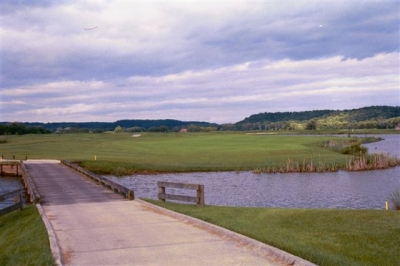 |
| Count on crossing several bridges on this water intensive layout. |
The sixth hole is a great par five (582 yards), with difficulty on all three shots. There's a demanding tee shot with a lateral hazard on the left, and a bunker. If you shy away from that and leave it too far right, you're blocked by a clump of trees. The second shot is into a dogleg, again with a lateral hazard on the left and a carry over a fairway bunker. The third shot's into a small, perched, undulating green.
Fifteen's a challenging par four (439 yards). It's a slight dogleg right with water down the right side, the entire length of the hole. The landing area is squeezed for the long-hitter, with the water on the right and a bunker on the left. If you choose to lay-up short, you'll have a long iron left to the green, again with water to the right.
Fikac says the 17th hole (183 yard par three) is 'controversial.' Here's why: "A lot of people like it, and some don't. It's got a very undulating green that kind of fades away from you -- so it requires a very high shot into a narrow green with a front and back bunker. It's very hard to get a ball close to the pin virtually anywhere on that green, except for maybe the front."
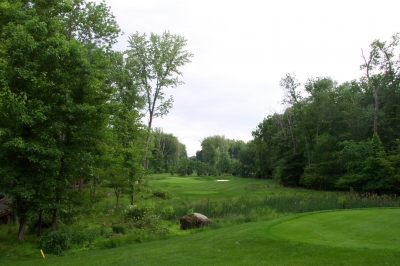 |
| Controversial or not, the 17th hole is beautiful to look at. |
Even if you're seething from the 'controversy' of the seventeenth hole (you probably won't be), the Lowes Island Club's amenities will make up for it. Again, Fikac expounds: "We've got a full service club, with six tennis courts, and we bubble them in the winter. We've got an exercise facility, 36 holes of golf, a driving range, and a short-game practice area. There's also a swimming pool, a dining room, a grill, a bar, a lounge, full locker rooms for men and women, and a masseuse by appointment."
Sounds like the full treatment. The Lowes Island Club's River Course provides an excellent, private club golf experience. Not a bad place to discover some different kinds of 'Hills' on the Potomac River.
Details:
Lowes Island Club's River Course
20391 Lowes Island Blvd
Sterling, VA 20165
Phone: (703) 444-4802
Website: www.lowesisland.com
Course Designer: Arthur Hills
Director of Golf: Bob Fikac
Course Superintendent: Byron Lash
| Tees | Yardage/Slope | Rating |
| Green | 7006/144 | 74.4 |
| Blue | 6502/136 | 71.7 |
| White | 6134/127, 136 (L) | 69.9, 75.1 (L) |
| Gold | 5627/126 (L) | 72.4 (L) |
| Red | 5269/116 | 70.3 |
Membership:
Memberships are available. Contact Mary Jo Hoskyns at (703) 444-4801 for inquiries.
| Related Links | Comments on this article? | |
|
Maryland National Golf Club Hollow Creek Golf Club Rocky Gap Resort PB Dye Golf Club in Ijamsville Whiskey Creek Golf Club |
E-mail Jeff Rendall, Editor: jrendall@golftheunitedstates.com |












